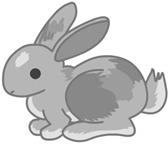|
The Soul and Animals
 "And the LORD God formed man of the dust of the ground, and breathed into his nostrils the breath of life; and man became a living soul" (Gen.2:7). The Hebrew nephesh has the primary significance of "breath" and points back to the account of man's first appearance on earth as a creature dependent on breathing in order to continue life. The use of nephesh, translated "soul", as a word descriptive of a living creature, is constant throughout the Old Testament. Animals are described as souls in Num.31:28. Souls are said to eat (Lev.17:10) to eat blood (Lev.17:12) to eat dead bodies (Lev.17:15) and to have a longing to eat flesh (Deut.12:20). They can be thirsty (Prov.25:25) and have a longing for strong drink (Deut.14:26). They may on the other hand have abhorrence for meat (Job 33:20). It is conceivable for souls to swear or to touch unclean things (Lev.5:2&4) and although all these operations denote life and that the soul is a living entity, it is also possible for the soul to be smitten by enemies (Josh.11:11) and to die (Ezek.18:4&20). References such as these can be found scattered all through the Old Testament. The word occurs seven hundred times and is translated "soul" 471 times, "life" or "living" 150 times, and also by such words as man, person, self, they, me, him, any one, breath, heart, mind, appetite, this body, lust, creature, and beast. Twenty‑eight times is the word applied to the lower animals. "And the LORD God formed man of the dust of the ground, and breathed into his nostrils the breath of life; and man became a living soul" (Gen.2:7). The Hebrew nephesh has the primary significance of "breath" and points back to the account of man's first appearance on earth as a creature dependent on breathing in order to continue life. The use of nephesh, translated "soul", as a word descriptive of a living creature, is constant throughout the Old Testament. Animals are described as souls in Num.31:28. Souls are said to eat (Lev.17:10) to eat blood (Lev.17:12) to eat dead bodies (Lev.17:15) and to have a longing to eat flesh (Deut.12:20). They can be thirsty (Prov.25:25) and have a longing for strong drink (Deut.14:26). They may on the other hand have abhorrence for meat (Job 33:20). It is conceivable for souls to swear or to touch unclean things (Lev.5:2&4) and although all these operations denote life and that the soul is a living entity, it is also possible for the soul to be smitten by enemies (Josh.11:11) and to die (Ezek.18:4&20). References such as these can be found scattered all through the Old Testament. The word occurs seven hundred times and is translated "soul" 471 times, "life" or "living" 150 times, and also by such words as man, person, self, they, me, him, any one, breath, heart, mind, appetite, this body, lust, creature, and beast. Twenty‑eight times is the word applied to the lower animals.
 The New Testament word corresponding to the Hebrew nephesh is psuche and this is translated "soul" 59 times, "life" 40 times, as well as mind, us, you, heart, and heartily, occurring one hundred and fifty times altogether of which two references are to the lower animals. The New Testament word corresponding to the Hebrew nephesh is psuche and this is translated "soul" 59 times, "life" 40 times, as well as mind, us, you, heart, and heartily, occurring one hundred and fifty times altogether of which two references are to the lower animals.
|